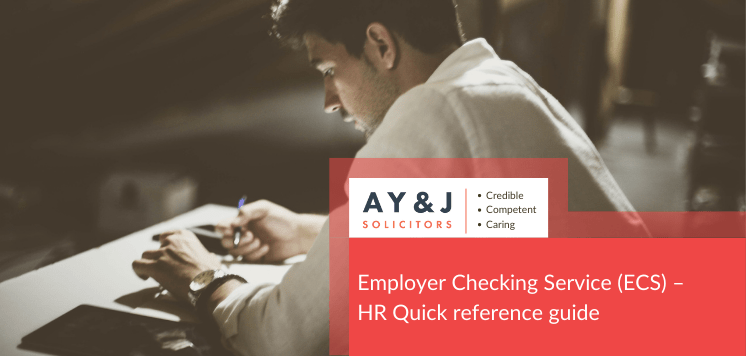Disclaimer: The information in this blog is accurate as of its publication date. Any updates after that date are not reflected here.
The Employer Checking Service (ECS) is specifically available to employers who wish to start or continue employing someone who has a valid and outstanding visa application, review, or appeal. Through the ECS, the employer can check the person’s Right to Work while the employee is waiting for a decision. The ECS can also be used for those who have been issued with a Certificate of Application (COA) or Application Registration Card (ARC) whilst waiting for their immigration decision.
As an employer or HR manager who undertakes right to work checks, you need to understand how to utilise the service, in order to comply fully with prevention of illegal working regulations.
Table of Contents
Why are right to work checks necessary?
If an employer is found to be employing staff who do not have any permission to work in the UK (or who do not have permission to undertake the specific job(s) in question), the employer could face a civil penalty (fine) of up to £20,000, per illegal worker. That is the case, even if you employed the person without knowing they had no right to work.
As the employer, it is down to you to check the potential employee’s right to work, in line with government guidance.
By making such a check, you gain what is known as a “statutory excuse” (or protection) against a fine or penalty if it turns out later that you unknowingly employed someone without permission to work in the UK.
If you don’t make a check in line with the guidance, and you are later found to have employed worker(s) illegally, you will not be able to rely on a “statutory excuse” to challenge or reduce the inevitable fine.
When should the Employer Checking Service be used?
As per the Home Office guidance, the following circumstances are examples of when this service may be needed:
- You are presented with a document (non-digital CoA or an acknowledgement letter or email) confirming receipt of an application to EUSS on or before 30 June 2021; or
- You are presented with a non-digital CoA confirming receipt of an application to the EUSS on or after 1 July 2021; or
- You have checked a digital CoA, using the online service, confirming receipt of an application to the EUSS on or after 1 July 2021, and been directed to the ECS; or
- You are presented with a valid Application Registration Card stating that the holder is permitted to undertake the work in question. Any work will be restricted to employment in a shortage occupation; or
- You are satisfied that you have not been provided with any acceptable documents because the person has an outstanding application with us which was made before their previous permission expired or has an appeal or administrative review pending and, therefore, cannot provide evidence of their right to work; or
- You consider that you have not been provided with any acceptable documents, but the person presents other information indicating they are a long-term resident of the UK who arrived in the UK before 1988.
How do I use the Employer Checking Service?
To access the service, you will need to visit www.gov.uk/employee-immigration-employment-status.
To process the application, you will need to enter the employee’s personal details, employment details any Home Office reference numbers/case ID. You’ll also need to supply your business name, industry and contact details.
Once this data has been entered and submitted through the relevant online form, the application will be reviewed by the Home Office (the person’s records will be checked to confirm the person has the Right to Work). This will take around five working days to be turned around.
A Positive Verification Notice (PVN) will be sent to the person making the check, if the Home Office can confirm that the individual has the right to work.
This PVN is evidence that you have conducted the correct right to work check and will give you a 6-month statutory excuse before needing to make a “follow up” check. As a right to work record keeping requirement, this PVN will need to be stored for up to two years after the individual has left your employment; this can be printed or saved electronically.
If the check comes back negative, (indicating that employee does not have the right to work in the UK or undertake the work in question), you should not employ or continue to employ the person because you will not be able to rely on the statutory defence against civil penalty. If you do employ them, knowing that an employee does not have the right to work, the consequences are significant; it could result in a criminal prosecution of up to 5 years and/or an unlimited fine.
What if my current employee has expiring leave?
As long as your current employee submitted their visa application before it expired, they will be able to continue working under the existing conditions of their visa while the decision is pending. As a current employer (making a “follow up check”) you have an extra 28 days to make a ECS check after the employee’s visa expiry date, provided you have obtained evidence they made an application before their leave expired.
Your ECS check will need to be carried out before the 28th day after the visa’s expiry date. Note that this 28-day additional “grace period” applies only to Right to Work “follow up” checks for current employees.
For new hires, you must receive a “PVN” from the Employer Checking Service before employing them, if that employee is waiting for a decision on their application/appeal.
Conclusion
The Employer Checking Service is a fantastic tool offered by the Home Office, which helps HR to facilitate the continuity of existing employees’ employment, while they extend or switch visa and also helps employers to legally hire new staff, who are waiting for decisions on their visa application or appeal.
A Y & J Solicitors is a specialist immigration law firm, with extensive experience in the field of “Right to Work” compliance and preventing illegal working. We have an in-depth understanding of immigration law and are professional and results-focused. For assistance with your sponsorship or any other UK immigration law concerns, please contact us on +44 20 7404 7933 or at contact@ayjsolicitors.com today. We’re here to help!









